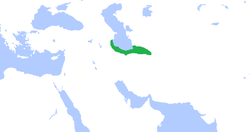Dabuyid dynasty
| Dabuyid dynasty | ||||||||||||||||
|
||||||||||||||||
|
The Dabuyid dynasty around its greatest extent under Farrukhan the Great
|
||||||||||||||||
| Capital |
Amol (early) Sari (late) |
|||||||||||||||
| Languages | Middle Persian, Caspian languages | |||||||||||||||
| Religion | Zoroastrianism | |||||||||||||||
| Government | Monarchy | |||||||||||||||
| Ispahbadh | ||||||||||||||||
| • | 640-660 | Gil Gavbara (first) | ||||||||||||||
| • | 740/41-759/60 | Khurshid (last) | ||||||||||||||
| Historical era | Middle Ages | |||||||||||||||
| • | Muslim conquest of Persia | 642 | ||||||||||||||
| • | Abbasid conquest of Tabaristan | 760 | ||||||||||||||
|
||||||||||||||||
| Today part of | ||||||||||||||||
The Dabuyid or Gaubarid Dynasty was a Zoroastrian Iranian dynasty that started in the early seventh century as an independent group of rulers, reigning over Tabaristan and parts of western Khorasan. Dabuyid rule over Tabaristan and Khorasan lasted from ca. AD 642 to the Abbasid conquest in 760.
The family's early history is semi-mythical, and recorded by the later historian Ibn Isfandiyar. According to this story, the Dabuyids were descended from a brother of the Sassanid shah Kavadh I. His grandson Firuz conquered Gilan, and Firuz's grandson Gil, surnamed Gavbara, then extended the family's rule over Tabaristan as well. This led to the formal conferment of the titles of Gil-Gilan ("ruler of Gilan") and Padashwargarshah ("Shah of Patashwargar", the old name of Tabaristan's mountains), to Gil's son Dabuya or Daboe, by the last Sassanid shah, Yazdegerd III. Following the Muslim conquest of Persia the Dabuyids established their domain as a quasi-independent principality, owing only nominal allegiance to the Arab Caliphate. In addition to the titles granted by Yazdegerd, the Dabuyid rulers also bore the old Iranian military rank of ispahbadh as their regnal title.
The first documented ruler of the Dabuyid line, however, is Farrukhan the Great, who repelled a great Muslim invasion under Yazid ibn al-Muhallab in 716–717, and who may in reality be the true founder of Dabuyid rule in Tabaristan; more recent research places his assumption of power there in the 670s instead of the early 710s, as hitherto assumed. Farrokhan died in 728, and was succeeded by his son, Dadmihr. Little is known of his reign, and he died at an early age in 740/741. His son and successor, Khurshid, was still a boy, and his uncle Farrukhan the Little ruled as regent for seven years. Khurshid ruled a prosperous state, and tried repeatedly, though without success, to break his ties to the Caliphate, exploiting the turmoil of the final years of the Umayyads and of the Abbasid Revolution. These attempts led to a large-scale invasion of Tabaristan in 759, forcing Khurshid to seek refuge in Gilan, where he poisoned himself in 761.
...
Wikipedia

